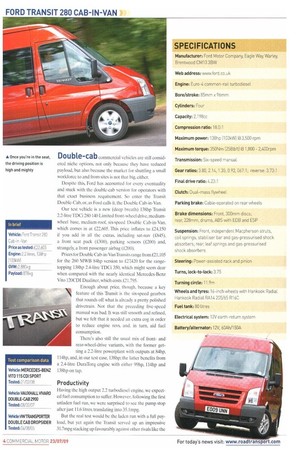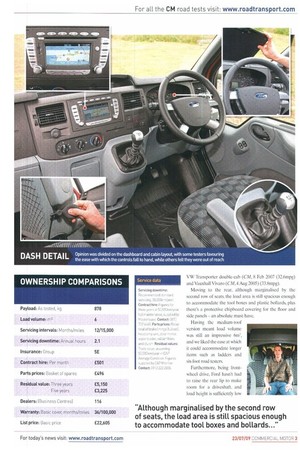Double-cab commercial vehicles are still considered niche options, not only
Page 34

Page 35

Page 36

If you've noticed an error in this article please click here to report it so we can fix it.
because they have reduced payload, but also because the market for shuttling a small workforce to and from sites is not that big, either.
Despite this, Ford has accounted for every eventuality and stuck with the double-cab version for operators with that exact business requirement. So enter the Transit Double-Cab, or, as Ford calls it, the Double Cab-in-Van.
Our test vehicle is a new (deep breath) 138hp Transit 2.2-litre TDCi 280 140 Limited front-wheel drive, mediumwheel base, medium-roof, six-speed Double Cab-in-Van, which comes in at £22,605. This price inflates to £24,150 if you add in all the extras, including sat-nay (£.845), a front seat pack (f300). parking sensors (£200) and, strangely, a front passenger airbag (f200).
Prices for Double Cab-in-Van Transits range from 121,105 for the 260 MWB 84hp version to £27.420 for the rangetopping 138hp 2.4-litre TDCi 350, which might seem dear when compared with the nearly identical Mercedes-Benz Vito 120CDI Dualiner, which costs £21795.
Enough about price, though, because a key feature of this Transit is the six speed gearbox that rounds off what is already a pretty polished drivetrain. Not that the preceding five-speed manual was bad. It was still smooth and refined, but we felt that it needed an extra cog in order to reduce engine revs, and, in turn, aid fuel consumption.
There's also still the usual mix of frontand rear-wheel-drive variants, with the former get ting a 2.2-litre powerplant with outputs at 84hp, 114hp, and, in our test case, 138hp; the latter benefits from a 2.4-litre DuraTorq engine with either 99hp, 114hp and 138hp on tap.
Productivity Having the high output 2.2 turbodiesel engine, we expected fuel consumption to suffer. However, following the first unladen fuel run, we were surprised to see the pump stop after just 11.6 litres, translating into 35.1mpg.
But the real test would be the laden run with a full payload, but yet again the Transit served up an impressive 31.7mpg stacking up favourably against other rivals like the
VW Transporter double-cab (CM, 8 Fcb 2007 (32.6mpg) and Vauxhall Vivaro (CM,4 Aug 2005) (33.8mpg).
Moving to the rear, although marginalised by the second row of seats, the load area is still spacious enough to accommodate the tool boxes and plastic bollards, plus there's a protective chipboard covering for the floor and side panels — an absolute must-have.
Having the medium-roof version meant load volume was still an impressive 6m1, and we liked the ease at which it could accommodate longer items such as ladders and six-foot road testers.
Furthermore, being frontwheel drive, Ford hasn't had to raise the rear lip to make room for a driveshaft, and load height is sufficiently low
to make packing a breeze. Speaking of which, a basic feature that Ford seems to have mastered (and some of its rivals have not) is the catch-release buttons on the rear doors, which allow them to extend a full 270 degree.
Cab comfort One of the big criticisms, however, that can be levelled against all Transits is the cab access. This is due to the fact that the front wheelarch humps intrude quite noticeably into the cabin, and it's not as easy to climb aboard as it is, say, a Renault Trafic or Peugeot Expert.
However, once you're in the seat, you'll enjoy the commanding driving position so much so that you'll even be looking down on 'bigwigs' in their Range Rovers. The seats are comfy and supportive, but the velour covering, although built for durability, looks and feels cheap.
While on the subject of seating, there's a multitude of adjustments, from winders to odd-looking lumbar pumps, plus an overly sensitive seat-raising mechanism that launches you backwards at the slightest of touches.
The dashboard and controls resemble those used in a Ford passenger car, especially the steering wheel and indicator stalks.
Opinions regarding the ergonomics were mixed, with some of our testers favouring the ease at which controls fall to hand, while others felt that buttons were a little too far out of reach most noticeable being the electric wing mirror adjustment.
Additionally, the steering wheel is fixed in place with no adjustment for reach or rake, and we found ourselves sitting closer to the controls than we'd prefer.
lhe generous amount of cabin storage is a strongpoint, and there's a space for almost any item you can think of: be it phones. A4 files, MP3 players, wallets or big bottles.
On the dashboard, there are two closing cubbies plus a parcel shelf below a flip-top tray that houses two drinks
holders. But there's a little too much hard plastic on the door coverings and dashboard, which you don't see in the Mercedes-Benz Vito.
Behind the second row of seats is a full-size bulkhead with a glass screen that insulates the cabin from road noise, but we have our reservations when it comes to security because it does expose the load area to break-ins.
On the road Starting up the 2.2-litre diesel, we're immediately surprised by the lack of engine chatter at idle. Engage first and the 138hp powerplant serves up plenty of torque from low-down, which allows for rapid progress. This is helped in part by a slick-shifting six-speed gearbox that feels refined and solid both in the stop-start urban environment and on the motorway.
Adding an extra cog to the Transit's powertrain has the advantage of lowering engine revs at the top end. Not only does this make for a quieter drive, but, more importantly, it has a positive effect on fuel economy.
And while we're on the topic of motorway driving, the Transit comes equipped with cruise control that was fairly easy to operate on our test route along the M25 and M20; and it was nice to know we didn't have to worry about maintaining a constant speed.
About town, the ride is composed for a vehicle this size, and the Transit Double Cab-in-Van grips well in the corners, and with minimal bodyroll makes it feel almost carlike in its approach. •








































































































































